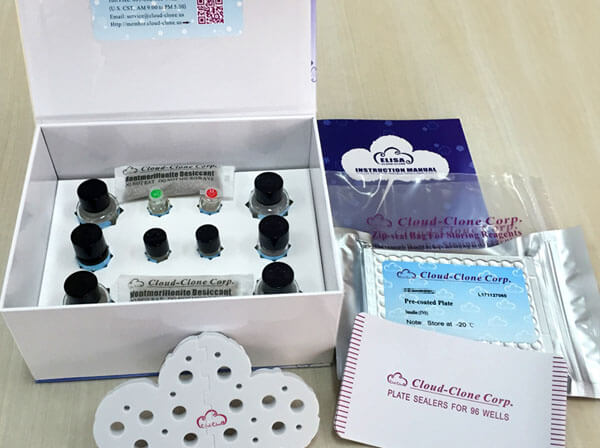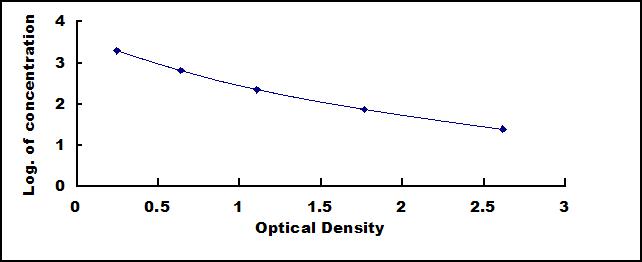ELISA Kit for Neuropeptide Y (NPY) 

NP-Y; PYY4; CPON; Pro-neuropeptide Y; Neuropeptide tyrosine; C-flanking peptide of NPY
- UOM
- FOB US$ 504.00 US$ 720.00 US$ 3,240.00 US$ 6,120.00 US$ 50,400.00
- Quantity
Overview
Properties
- Product No.CEA879Gu
- Organism SpeciesCavia (Guinea pig ) Same name, Different species.
- ApplicationsEnzyme-linked immunosorbent assay for Antigen Detection.
Research use only - DownloadInstruction Manual
- CategoryMetabolic pathwayEndocrinologyCardiovascular biologyNeuro scienceHepatology
Sign into your account
Share a new citation as an author
Upload your experimental result
Review

Contact us
Please fill in the blank.
Recovery
Matrices listed below were spiked with certain level of recombinant Neuropeptide Y (NPY) and the recovery rates were calculated by comparing the measured value to the expected amount of Neuropeptide Y (NPY) in samples.
| Matrix | Recovery range (%) | Average(%) |
| serum(n=5) | 94-103 | 98 |
| EDTA plasma(n=5) | 94-105 | 97 |
| heparin plasma(n=5) | 90-101 | 95 |
Precision
Intra-assay Precision (Precision within an assay): 3 samples with low, middle and high level Neuropeptide Y (NPY) were tested 20 times on one plate, respectively.
Inter-assay Precision (Precision between assays): 3 samples with low, middle and high level Neuropeptide Y (NPY) were tested on 3 different plates, 8 replicates in each plate.
CV(%) = SD/meanX100
Intra-Assay: CV<10%
Inter-Assay: CV<12%
Linearity
The linearity of the kit was assayed by testing samples spiked with appropriate concentration of Neuropeptide Y (NPY) and their serial dilutions. The results were demonstrated by the percentage of calculated concentration to the expected.
| Sample | 1:2 | 1:4 | 1:8 | 1:16 |
| serum(n=5) | 87-97% | 94-102% | 82-91% | 86-99% |
| EDTA plasma(n=5) | 98-105% | 94-101% | 78-101% | 85-102% |
| heparin plasma(n=5) | 79-89% | 78-103% | 93-102% | 92-105% |
Stability
The stability of kit is determined by the loss rate of activity. The loss rate of this kit is less than 5% within the expiration date under appropriate storage condition.
To minimize extra influence on the performance, operation procedures and lab conditions, especially room temperature, air humidity, incubator temperature should be strictly controlled. It is also strongly suggested that the whole assay is performed by the same operator from the beginning to the end.
Reagents and materials provided
| Reagents | Quantity | Reagents | Quantity |
| Pre-coated, ready to use 96-well strip plate | 1 | Plate sealer for 96 wells | 4 |
| Standard | 2 | Standard Diluent | 1×20mL |
| Detection Reagent A | 1 | Assay Diluent A | 1×12mL |
| Detection Reagent B | 1×120µL | Assay Diluent B | 1×12mL |
| Reagent Diluent | 1×300µL | Stop Solution | 1×6mL |
| TMB Substrate | 1×9mL | Instruction manual | 1 |
| Wash Buffer (30 × concentrate) | 1×20mL |
Assay procedure summary
1. Prepare all reagents, samples and standards;
2. Add 50µL standard or sample to each well.
And then add 50µL prepared Detection Reagent A immediately.
Shake and mix. Incubate 1 hour at 37°C;
3. Aspirate and wash 3 times;
4. Add 100µL prepared Detection Reagent B. Incubate 30 minutes at 37°C;
5. Aspirate and wash 5 times;
6. Add 90µL Substrate Solution. Incubate 10-20 minutes at 37°C;
7. Add 50µL Stop Solution. Read at 450 nm immediately.

Test principle
This assay employs the competitive inhibition enzyme immunoassay technique. A monoclonal antibody specific to Neuropeptide Y (NPY) has been pre-coated onto a microplate. A competitive inhibition reaction is launched between biotin labeled Neuropeptide Y (NPY) and unlabeled Neuropeptide Y (NPY) (Standards or samples) with the pre-coated antibody specific to Neuropeptide Y (NPY). After incubation the unbound conjugate is washed off. Next, avidin conjugated to Horseradish Peroxidase (HRP) is added to each microplate well and incubated. The amount of bound HRP conjugate is reverse proportional to the concentration of Neuropeptide Y (NPY) in the sample. After addition of the substrate solution, the intensity of color developed is reverse proportional to the concentration of Neuropeptide Y (NPY) in the sample.
Giveaways
Increment services
Citations
- Is there any interaction of resistin and adiponectin levels with protein‐energy wasting among patients with chronic kidney diseaseOnlinelibrary: hdi.12072
- Changes in growth pattern, leptin ghrelin and neuropeptide Y levels after adenotonsillectomy in prepubertal childrenDegruyter: Source
- The role of adipocytokines on depressive symptoms of patients with chronic kidney diseasePubmed: 23879728
- The relationship of plasma neuropeptide Y levels with coronary collateral development.Pubmed: 24077326
- The relationship of plasma neuropeptide Y levels with coronary collateral developmentLww:Source
- Possible role of serotonin and neuropeptide Y on the disruption of the reproductive axis activity by perfluorooctane sulfonatePubmed:25623392
- High Plasma Levels of Neuropeptide Y Correlate With Good Clinical Outcome But are not Correlated to Cerebral Blood Flow or Vasospasm After Subarachnoid HemorrhagePubMed: 25955865
- High Intensity Aerobic Exercise Training Improves Deficits of Cardiovascular Autonomic Function in a Rat Model of Type 1 Diabetes Mellitus with Moderate …Pubmed:26885531
- Binge eating and biochemical markers of appetite in new users of the contraceptive depot medroxyprogesterone acetatepubmed:27604241
- Effects of Di-isononyl Phthalate on Neuropeptide Y Expression in Differentiating Human Neuronal Cells.pubmed:27625336
- Aberrant changes of somatostatin and neuropeptide Y in brain of a genetic rat model for epilepsy: tremor ratpubmed:27685769
- Nur77 protects against adverse cardiac remodelling by limiting Neuropeptide Y signalling in the sympathoadrenal-cardiac axisPubmed:29850786
- Salivary neuropeptides, stress, and periodontitisPubmed:28914594
- Mechanisms of sustained long-term weight loss after RYGB: α-MSH is a key factorPubmed:29685637
- Melatonin Induces Osteoblastic Differentiation of Mesenchymal Stem Cells and Promotes Fracture Healing in a Rat Model of Femoral Fracture via Neuropeptide Y …Pubmed: 30227410
- Investigation of the relationship between insulin resistance and neuropeptide Y levels in polycystic ovary syndrome
- Investigation of the relationship between insulin resistance and neuropeptide Y levels in polycystic ovary syndrome.
- Sevoflurane Induces Hippocampal Neuronal Apoptosis by Altering the Level of Neuropeptide Y in Neonatal Rats.Pubmed: 32378074
- Serum levels of neuropeptide Y in patients with chronic schizophrenia during treatment augmentation with sarcosine (results of the double©\blind randomized?¡33245168
- Serotonin involvement in okadaic acid-induced diarrhoea in vivo34148100

















